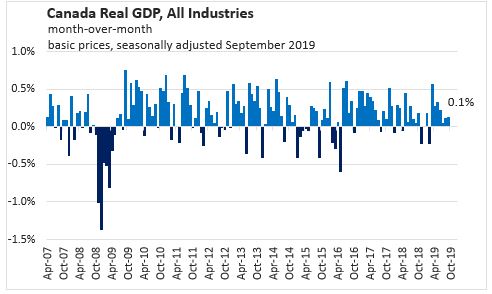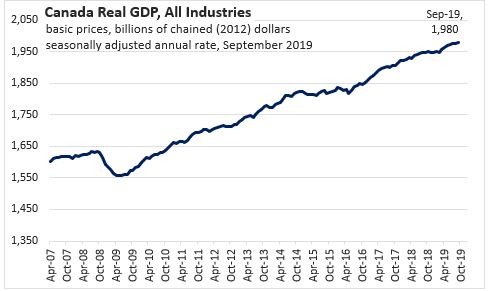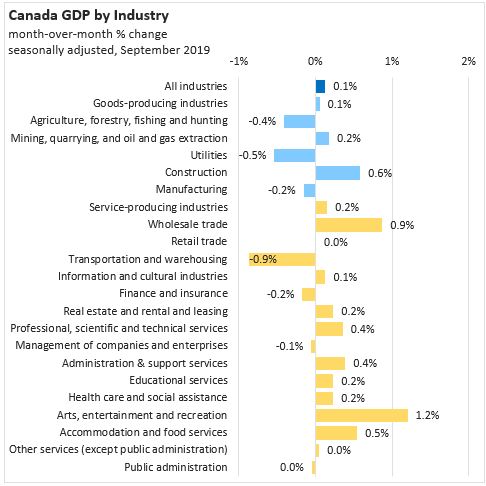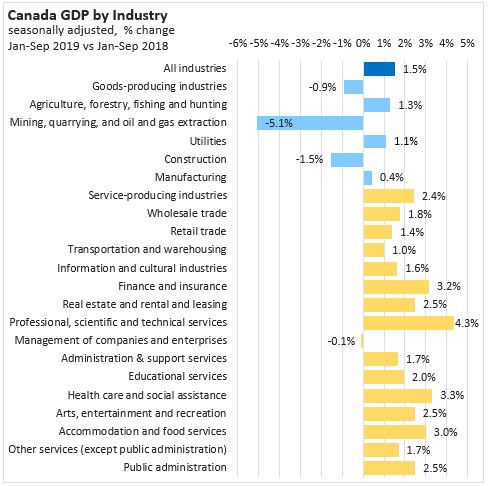The Economics and Statistics Division maintains archives of previous publications for accountability purposes, but makes no updates to keep these documents current with the latest data revisions from Statistics Canada. As a result, information in older documents may not be accurate. Please exercise caution when referring to older documents. For the latest information and historical data, please contact the individual listed to the right.
<--- Return to Archive
For additional information relating to this article, please contact:
November 29, 2019CANADA GDP BY INDUSTRY, SEPTEMBER 2019 
Real GDP in Canada increased by 0.1 per cent for the third consecutive month in September. Goods-producing industries increased 0.1 per cent and service-producing industries were up 0.2 per cent. Compared to September 2018, the Canadian economy is 1.6 per cent larger with an annualized value of $1,980 billion (chained 2012 dollars) in September 2019.

Agriculture, forestry, fishing and hunting declined 0.4 per cent in September due to further declines in forestry and logging.
Oil and gas extraction rose 0.4 per cent after two months of decline. Oil sands extraction rose 1.1 per cent on higher crude bitumen extraction, while oil and gas extraction outside of the oil sands declined as lower natural gas extraction more than offset increases in crude petroleum extraction. Mining and quarrying (except oil and gas) declined 2.1 per cent in September with declines in potash, coal, and iron ore offsetting increases in copper, nickel, lead and zinc ore mining.
Construction grew 0.6 per cent with increases in all subsectors. The rise in residential construction fully offset declines in the previous two months on higher home alterations and improvements and multi-unit construction. Growth in non-residential construction was led by an increase in industrial and commercial construction.
Manufacturing declined for the third time in four months as growth in durables (0.3 per cent) was offset by a decline in non-durables (0.7 per cent). Durables rose on higher machinery, furniture, and primary metal manufacturing. Transportation equipment manufacturing declined due to lower activity driven by the United Auto Workers strike in the United States, leading some Canadian parts plants to scale back production. The decline in non-durables was led by declines in chemical, paper, and printing and related support activities.
Wholesale trade was up 0.9 per cent in September, offsetting a decline in August. There were increases in six of nine subsectors, led by machinery and equipment. Lower imports contributed to a decline in motor vehicle and parts wholesaling. Retail trade was unchanged in September.
Transportation and warehousing declined for the fourth consecutive month as six of nine subsectors contracted. Rail transportation was down 7.2 per cent in September due to trade-related declines in mining production and delayed harvest of grains and oilseeds in the Prairies due to significant snowfall.
Finance and insurance was down 0.2 per cent in September following six months of growth. Declines in financial investment services, funds and other vehicles and insurance carriers offset increases in depository credit intermediation and monetary authorities.
Real estate and rental and leasing rose on activity at offices of agents and brokers, mainly due to higher housing resale activity in the Greater Vancouver Area and Fraser Valley in British Columbia. Professional and technical services rose on growth in legal, accounting and related services, bolstered by real estate transactions.

Comparing the size of the Canadian economy in January-September 2019 with January-September 2018, there has been a 1.5 per cent increase due to higher service sector output (+2.4 per cent) while the goods-producing sector declined by 0.9 per cent. Higher levels of activity in agriculture, forestry, fishing and hunting, utilities and manufacturing only partially offset the lower levels of activity in mining, quarrying, and oil and gas extraction and construction. Service sector output is higher across all subsectors, except management of companies and enterprises, with the largest increases in professional, scientific and technical services, health care and social assistance, finance and insurance, and accommodations and food services subsectors.

Source: Statistics Canada.
Table 36-10-0434-01 Gross domestic product (GDP) at basic prices, by industry, monthly (x 1,000,000)
<--- Return to Archive